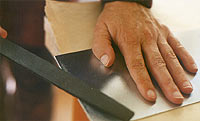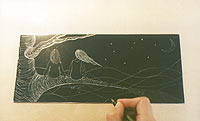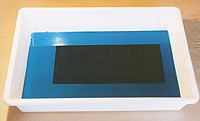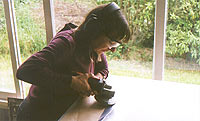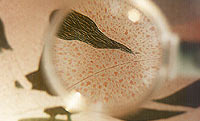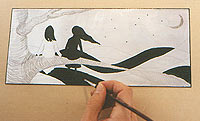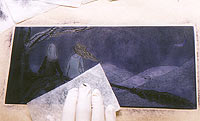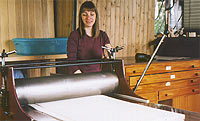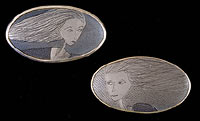Etching Process
Etching is a strange and complex process, invented five centuries ago for the decoration of armour, and subsequently used by jewellers, artists & illustrators.
First the zinc plate is polished and bevelled and a protective hard ground of asphaltum and beeswax is laid down. With a fine needle the image is drawn into the ground exposing the plate beneath.
The plate is then immersed in a bath of copper sulphate (the mordant). Line and texture are created as the corrosive salt bites into the metal plate. Layer upon layer of this process gives the final print a wonderful sense of depth and subtlety.
There are many ways to create marks in the plate that will hold ink. Inventing new ones is one of the joys of printmaking. Sometimes I press fabric into a soft ground and etch the design that is left behind or I might carve directly into the plate using a dremmel or angle grinder, or simply brush the plate with sandpaper - all processes known as drypoint.
To create tones, a fine mist of clay or enamel particles is sprayed onto the plate. Depending on how many layers I spray and etch and how long the plate is left in the mordant, I can create tones from a delicate wash to rich velvety blacks. This is known as aquatint.
As each layer is created, a stop-out must be applied to the plate to prevent the mordant eating away areas that are to remain white on the paper, or areas where the present texture or tone is not required. This is a painstaking procedure often requiring a magnifying glass and fine 00 paintbrush.
Many of the processes in etching are unpredictable, the precise effect on the image unknown until it has been printed. This can be both frustrating and exhilarating as the process adds so much to the image.
Once the etching is complete, the plate is inked up, the ink forced into the grooves and pits by a bevelled piece of card and the excess ink tissued away. The plate is wiped over and over again to ensure no ink remains on the flat surfaces where the image is to be white on the paper. Care must be taken not to lift ink from the deep aquatints which would result in patchy, uneven blacks.
Travelling through the press at a pressure of two tons, the damp paper fibres are forced into all the grooves and pits to pick up the ink and the image is embossed into the paper. At last I see the image I have created.
When dry I sign and title the image and must decide upon the edition number. How many of this image will I print? The number of the edition is the bottom number, the top is the number of that individual print. So 1/15 means this is the first of 15 etchings from this plate.
After the edition is completed the plate is marked or destroyed. I do not like to waste such gorgeous textures so often I will cut ovals from the metal plate and have a jeweller make them into unique brooches.

